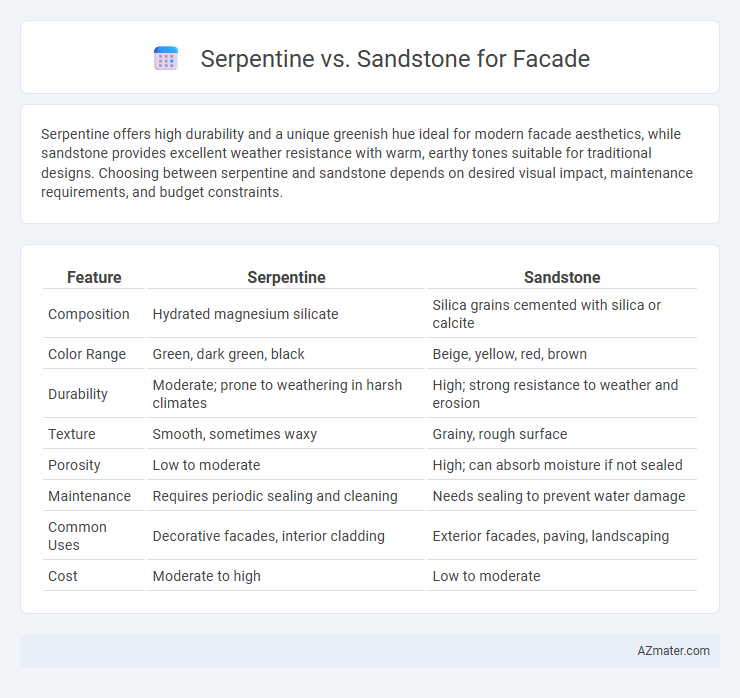Serpentine offers high durability and a unique greenish hue ideal for modern facade aesthetics, while sandstone provides excellent weather resistance with warm, earthy tones suitable for traditional designs. Choosing between serpentine and sandstone depends on desired visual impact, maintenance requirements, and budget constraints.
Table of Comparison
| Feature | Serpentine | Sandstone |
|---|---|---|
| Composition | Hydrated magnesium silicate | Silica grains cemented with silica or calcite |
| Color Range | Green, dark green, black | Beige, yellow, red, brown |
| Durability | Moderate; prone to weathering in harsh climates | High; strong resistance to weather and erosion |
| Texture | Smooth, sometimes waxy | Grainy, rough surface |
| Porosity | Low to moderate | High; can absorb moisture if not sealed |
| Maintenance | Requires periodic sealing and cleaning | Needs sealing to prevent water damage |
| Common Uses | Decorative facades, interior cladding | Exterior facades, paving, landscaping |
| Cost | Moderate to high | Low to moderate |
Introduction: Serpentine vs Sandstone for Facades
Serpentine and sandstone are popular materials for building facades, each offering distinct aesthetic and structural qualities. Serpentine provides a unique, greenish hue with a smooth texture, making it ideal for contemporary designs, while sandstone offers warm earth tones and excellent durability suited for traditional and rustic styles. Choosing between serpentine and sandstone depends on factors like climate resistance, maintenance needs, and desired architectural appearance.
Geological Origins and Composition
Serpentine originates from the metamorphism of ultramafic rocks, primarily composed of magnesium silicate minerals, giving it a distinctive greenish hue and smooth texture. Sandstone forms from the compaction and cementation of sand-sized mineral particles, mainly quartz and feldspar, resulting in a granular texture and varied colors depending on mineral content. The geological processes and mineral composition strongly influence the durability, appearance, and weathering patterns of serpentine and sandstone facades.
Visual Appeal: Color and Texture Comparison
Serpentine offers a unique visual appeal with its rich green hues and smooth, often veined texture that adds depth and elegance to facades. Sandstone features warm, earthy tones ranging from cream to reddish-brown with a naturally granular texture that enhances rustic and classic architectural styles. The choice between serpentine and sandstone significantly influences the facade's aesthetic, balancing vibrancy and sophistication against warmth and natural ruggedness.
Durability and Weather Resistance
Serpentine offers moderate durability and resistance to weathering, making it suitable for facades in mild to moderate climates, but it may be prone to surface degradation over time due to its relatively softer composition. Sandstone is highly durable and exhibits excellent weather resistance, particularly in harsh environmental conditions, due to its dense grain structure and natural weatherproof qualities. For facade applications, sandstone generally provides superior longevity and less maintenance compared to serpentine, especially in regions with extreme temperature fluctuations or heavy rainfall.
Maintenance Requirements
Serpentine facades require regular sealing and cleaning to prevent discoloration and erosion due to their susceptibility to weathering and mineral leaching. Sandstone facades demand periodic inspection for surface erosion and biological growth, with gentle cleaning methods to preserve the stone's porosity and structural integrity. Both materials benefit from protective coatings, but sandstone generally offers lower maintenance costs over time due to its greater resistance to environmental damage.
Installation Process and Techniques
Serpentine requires specialized cutting tools and careful handling due to its softness and susceptibility to fracturing during facade installation, necessitating skilled labor for precise fitting and anchoring. Sandstone, known for its durability and uniform hardness, allows for more straightforward cutting and setting techniques, making the installation process faster and less prone to damage. Both materials benefit from mechanical fixing methods and proper moisture barriers to ensure long-term facade stability and performance.
Cost Analysis: Serpentine vs Sandstone
Serpentine typically costs less than sandstone due to its widespread availability and lower quarrying expenses. Sandstone's price fluctuates depending on its grain size, color, and source, often resulting in higher transport and processing fees. When budgeting for facades, serpentine offers a more cost-effective option without compromising durability, whereas sandstone may incur greater initial investments but provide varied aesthetic appeal.
Environmental and Sustainability Factors
Serpentine, a metamorphic rock known for its durability and low porosity, offers excellent environmental benefits by reducing water absorption and minimizing maintenance needs on facades. Sandstone, while aesthetically appealing and widely available, tends to be more porous and requires frequent sealing to prevent weathering, potentially increasing environmental impact through maintenance chemicals. Choosing serpentine over sandstone can enhance sustainability by prolonging facade lifespan, lowering resource consumption, and supporting eco-friendly building practices.
Common Architectural Applications
Serpentine, known for its rich green hues and smooth texture, is frequently used in decorative cladding and sculptural facade elements to add visual depth and natural elegance to buildings. Sandstone, characterized by its durability and warm earth tones, is preferred for structural facade components, including load-bearing walls and intricate carvings, offering both strength and timeless appeal. Both materials are prominent in historic and contemporary architecture, with serpentine favored for ornamental appeal and sandstone prized for its versatility and weather resistance.
Choosing the Right Stone for Your Facade
Serpentine and sandstone each offer unique benefits for facade applications, with serpentine known for its distinctive green hues and durability, while sandstone provides versatile textures and warm earth tones. Selecting the right stone depends on factors such as climate resistance, maintenance requirements, and architectural style compatibility. Evaluating these properties ensures a facade that balances aesthetic appeal with long-term performance.

Infographic: Serpentine vs Sandstone for Facade
 azmater.com
azmater.com